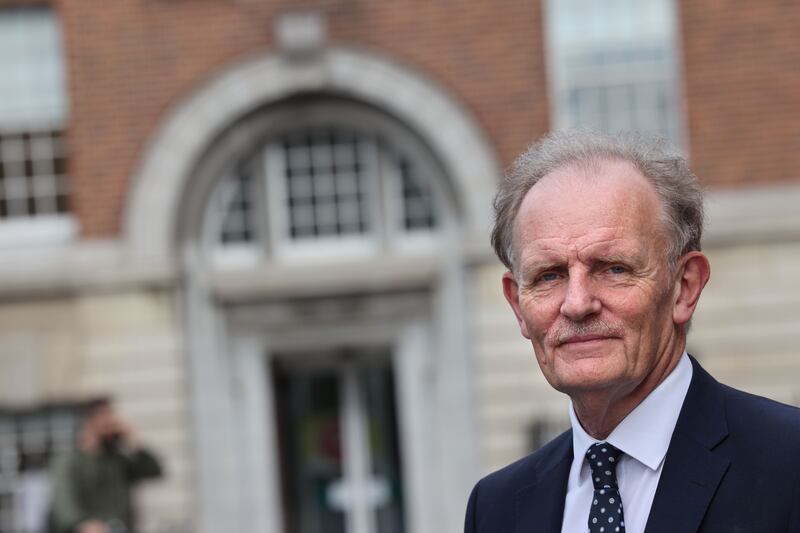Every newborn baby is checked for a potentially debilitating issue in the hips, known as developmental dysplasia, before they leave the maternity hospital and again at their six-week check-up.
However, a group of Irish doctors have highlighted the low diagnostic accuracy of this routine clinical examination and raised the question of the need for universal ultrasound screening. Only babies with known risk factors are routinely screened with ultrasound in Ireland, whereas in some other European countries, such as Germany and Austria, all babies are.
“Even in experienced hands, developmental dysplasia of the hip (DDH) is not reliably picked up by clinical examination and parents only tend to notice something being amiss when it is too late,” says paediatrician Prof Alfred Nicholson, vice-president for academic affairs and head of school of medicine at the RCSI Medical University of Bahrain. He is the lead author of a recent article by the doctors in the British Medical Journal that asks whether the condition easily missed and looks at the case for checking all babies with ultrasound.
“A missed case of severe DDH is consequential for infants and children, leading to need for surgery and lifelong disability, both of which may be associated with poor outcomes,” the article warns. “In the UK, Australia and the US, DDH continues to be one of the leading causes for medical malpractice against doctors working in general practice and paediatricians.”
READ MORE
Late diagnosis of this condition not only requires corrective surgery in infancy/childhood, but also results in a much higher risk of early osteoarthritis in 50-60-year-olds and a need for hip replacement, says Nicholson. The potential downside of checking all babies with ultrasound is the possibility of overtreatment, but “the experience in countries with universal screening is very positive”, he adds.
Most parents are likely to be unaware of the unreliability of the newborn and six-week checks to pick up DDH, so here’s a guide to the condition.
What is developmental dysplasia of the hip?

It is the most common joint problem in newborn infants. The hip is one of only two ball and socket joints in the body, the other being the shoulder. Such joints are complex and potentially troublesome. For babies, it is the hip, where the round head of the thigh bone (femur) fits into a cup-like socket (acetabulum), that is vulnerable.
The original name for the condition was congenital dislocation of the hip, “but that gave the impression you could always detect it at birth”, says consultant neonatologist Prof John Murphy. There are also cases where if the socket is too shallow or does not deepen as it should, then the hip is unstable and the growing thigh bone slips out during subsequent months.
At the National Maternity Hospital in Holles Street, Dublin, where Prof Murphy works, clinical examination picks up dislocation of a hip in five out of every 1,000 newborns. Girls are three times more commonly affected than boys.
Dislocation sounds very painful?
Actually, it does not seem to be for a newborn.
It is “silent and painless”, says Prof Murphy, who leads the National Clinical Programme for Paediatrics and Neonatology. This is why the condition is sometimes not detected until a baby starts to crawl with a leg dragging, or a toddler walks with a limp. The trouble is that if it is only diagnosed then, corrective surgery is likely to be required.
To avoid such complications, the condition needs to be picked up as early as possible.
How would it be detected in my child?

All newborn’s hips are tested for this as soon as possible after birth, along with various other routine checks. This clinical examination is carried out in the maternity hospital, by a paediatrician or a specially trained midwife.
Babies with certain risk factors will also be checked by ultrasound around four to six weeks, even if the physical examination did not indicate any concerns.
What are the risk factors?
Babies born in breech position are five times more likely to be affected. For babies with a positive family history, ie a sibling or parent had the condition, the likelihood is three times above average. A breech presentation at 36 weeks or more is also considered a risk even if the baby turned before birth.
About 20 per cent of babies fall into the “risk” category and are referred to the selective hip ultrasound programme that operates in all 19 maternity hospitals and units across the country. This ultrasound screening would be done when the baby is four to six weeks old.
In Holles Street, 10,952 targeted hip ultrasounds were performed in 2022, which equated to 19.5 per cent of the babies born there that year. Varying degrees of hip dysplasia were picked up in an additional 3 per cent of these who had been deemed normal on clinical examination.
While the national policy of selective screening is effective in these high risk cases, “the great majority of late diagnoses of DDH cases do not have the above risk factors”, says Prof Nicholson.
If my baby gets the all-clear in the maternity hospital examination and has no risk factors, will their hips be checked again?
Yes, the GP who does checks on your baby at six weeks old will look at the hips again. “GPs often detect concerns with hips in these early weeks and are experienced in referring suspected cases for imaging at this stage,” says GP Dr Sarah Taaffe, a co-author of the BMJ article. “Despite experience, DDH remains a difficult diagnosis due to the low diagnostic accuracy of the exam at the six-week baby check.”
Both she and Prof Murphy mention the important role public health doctors and nurses play in detecting later cases of DDH. They are very vigilant for this, he says, when doing baby checks at three months and seven-nine months. In one study of 84 late cases, 66 per cent originated from public health referrals. All cases picked up a maternity hospital, GP or public health will be referred to a paediatric orthopaedic surgeon.
What is the treatment for newborns where DDH is detected?

When the condition is picked up through a clinical examination, an ultrasound scan would be done to confirm the diagnosis. If the ultrasound is indicating just a danger of dislocation, the baby might be monitored with repeat ultrasounds. Unlike X-rays, no radiation is involved in ultrasound so can be done without any concern on that front.
For babies under six months with confirmed DDH, the hips cans usually be corrected with the fitting of a device known as the Pavlik harness. Named after its inventor, Czech surgeon Arnold Pavlik (1902-1965), this holds the legs apart and enables the hips to develop into a more normal position. It is worn for about two to three months.
However, in older babies it is quite difficult to get the head of the bone back into the socket. At that stage it may require either a “closed reduction”, where it is done in theatre under anaesthesia, says Prof Murphy, “or sometimes surgically they may have to go in and do an ‘open reduction’ to put the ball back into the socket. The later the diagnosis, the more likely the child is going to need an operation or a number of operations to treat the hip problem.”
The number of babies requiring surgery for DDH is estimated at about 0.4-0.6 per 1,000, but the exact rate is hard to determine.
If some babies are slipping through the diagnostic net, what should I as a parent look out for?
As the weeks go by after birth the hips will get tight, says Prof Murphy. You might notice when changing a nappy that a leg seems restricted in movement on one side compared with the other. Sometimes one leg may appear shorter than the other, if it has been dislocated upwards.
It is very easy to get an ultrasound done, he says, if you have any concerns and your maternity hospital should be able to do it up to about three months. Later, an X-ray is more likely to be required and that would be done in a children’s hospital.
Any dragging of the leg when the baby starts to crawl is another red flag, as is a limp on walking.
Should universal ultrasound screening be rolled out?
“There are arguments both ways, quite honestly,” says Prof Murphy. For a start, it’s a much bigger exercise than selective screening, if each of the 60,000-plus babies born in this country every year were to be scanned. Ultrasound screening for this cannot be done before babies are discharged from the maternity hospital because immaturity of the hips would result in too many unreliable readings; they need to be called back at four to six weeks of age.
There is also the concern that there might be too many false positives if all babies were screened, resulting in overtreatment. This would have to be weighed up against the benefit of reducing the long-term consequences of missed DDH.
However, he and his colleagues would like the National Screening Advisory Committee to consider the proposition. “We would like their opinion on it in a balanced kind of way,” says Prof Murphy, who points out that they don’t have universal screening in the UK, the US or Australia. But, he adds, “in an ideal world, universal screening would be the way forward”.
If the committee, which is an independent panel set up in 2019 to advise the Minister for Health, thought there was a case for it, it would be up to the Health Information and Quality Authority to look more closely at the desirability and feasibility of providing such a service and advising the Minister accordingly.






















